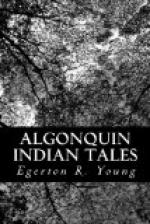So even now, while being carried away among the dense trees, they merrily laughed and shouted to each other. The bright patches of sunshine on the ground, the singing birds, and the few brilliant-hued summer flowers, brought forth their exclamations of delight, while all the time the grave, silent Indians hurried them on deeper and deeper into the forest. Yet carefully they guarded their precious loads, and as the antlered deer in passing through the thick woods and under the low branches never strike trunk or bough, so these sons of the forest glided swiftly on without allowing any hurt to come to the children of the paleface, even if at times the faint trail led them over slippery rocks and under low intertwining branches.
The wigwam of Souwanas was pitched in a beautiful spot at the edge of the great forest near the sandy, rocky eastern shore of Lake Winnipeg. This great lake is well called The Sea, which is the meaning of its Indian name. It is about as long as Lakes Ontario and Erie combined and in some places is eighty miles wide.
At the entrance of the wigwam, which was made of a couple of tanned reindeerskins, the children were carefully lifted down from the men’s shoulders and then taken into this Indian abode. Coming in suddenly from the bright sunshine it was some time before they could see distinctly. The door flap of deerskin had dropped like a curtain behind them. All the light there was came in through the hole in the top, where the poles of the wigwam crossed each other. Presently, however, they were able to see a circle of Indian children gathered around a small fire that smoldered on the ground in the center of the tent. It was now in the pleasant summer time, but the fire was needed for something else than warmth, as the little Sagastao and Minnehaha discovered before long. They were soon seated in the circle with the red children, who, young though they were, were a wee bit startled at seeing these little palefaces. The white children, however, simply laughed with glee. This outward demonstration seemed very improper to the silent red children, who were taught to refrain from expressions of their gladness or sorrow.
The Indians had brought the white children for a characteristic reason. They had said among themselves, “If the white father and mother love us as they say they do we will test them by taking away their children without asking permission.” They also wished to show their own love for the children, and so had really brought them to a children’s feast.
It was perhaps as queer a tea party as you ever heard of. There was no table on which to put the good things prepared for the feast. No plates, no cups and saucers, no knives, no spoons, not even a chair! There were no cakes, no tarts, no jam, no pies, not even any bread and butter!
“Well, what a feast!” you say. “Without any place to sit, or good things to eat!” Not too fast! There were both of these. There was the lap of mother earth, and so down on the ground, with bearskins and deerskins on it for rugs, the children sat. Then the deerskin door was again opened and in came Indians with birch-bark dishes, called rogans, in which were nicely prepared wild ducks, rabbits, and partridges. But as they were uncooked they could not yet be eaten by the now expectant, hungry children.




